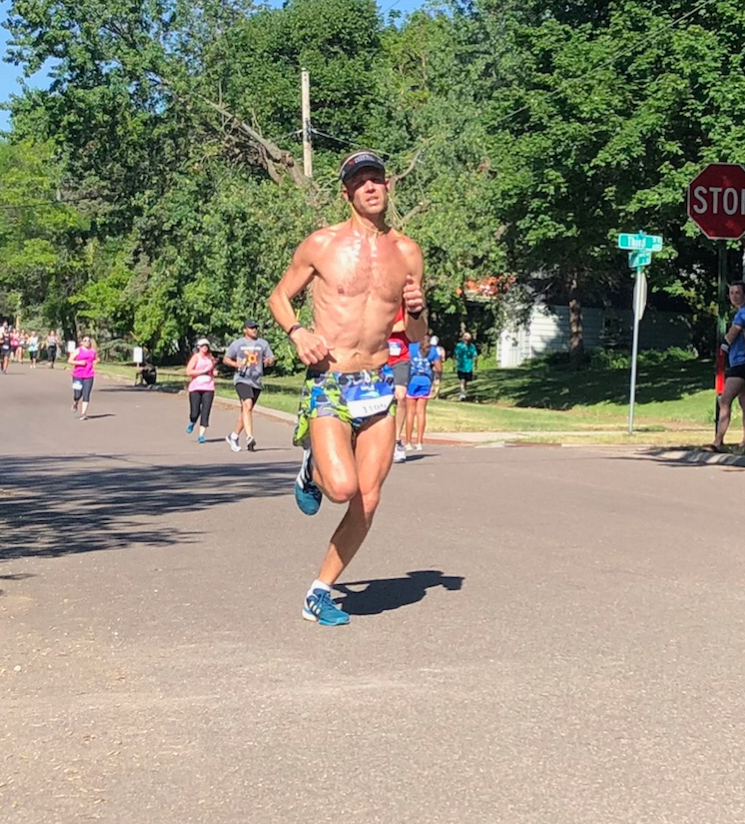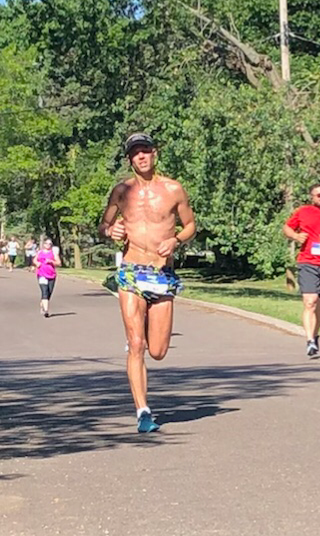Runners
-
-
@den1mhead I wouldn't worry about it at all. 3 months is a serious break. If you are paying attention to your Garmin while you run I would focus entirely on what you're heart rate is rather than pace. If you know you are around 135-140 BPM while running easy then try and hover in that range for the next 3-4 weeks. Assuming you've been able to consistently run over that first month you will probably be feeling much more like your old self by the end of it. You will also probably notice you are running faster while holding the same BPM range. After 4-6 weeks of easy to very moderate effort running I would then reassess where you are relative to where you were prior to the break. Assuming you're feeling more like your old self you can then begin incorporating more of the workout and distance structure you had built prior to the break. This buildup could take another 4-6 weeks.
My college coach always used to say that if you take a week off it will take you two weeks to get back to your pre-break self. Granted we were a bunch of division one athletes in ridiculously good shape, but the real point he was making is that it's always important to take your time coming back to avoid any sort of injury.
-
@cander49 I use a Garmin 235 which is a wrist based HRM however I also have a chest strap that works, instead of the wrist, with my 235. TBH they both give very similar results
@BloodnThunder thanks for the advice, and you too cander49. What I'm hearing is be patient over the next month to six weeks and train on my heart rate whilst running at an easy to very moderate effort (135-140 bpm). Sound advice fellas that I will stick too. Thanks for taking the time
-
@den1mhead exactly. I would look back to what your heart rate was on easy days when you were running consistently before the break. That will give you a good idea of where you should try to be during this first 4-6 weeks. Ultimately your pace should be a good amount slower than it was but the effort will be very similar. As your body starts responding to the training you will begin running faster without any additional effort.
-
@den1mhead , yeah, patience is key. I would also focus mostly on how the effort feels to you. Personally, I don't pay any attention to heart rate in training, even though I have a chest strap that seems accurate. For me, it's all about the feel, which is something more about intuition than one specific number. Heart rate is certainly a piece of that, but other important keys are how my legs feel, how easily I could surge the pace if I wanted to, overall level of fatigue, etc, and all of these pieces fluctuate. Sometimes my easy pace is 8:30/mile, while sometimes it's 6:30/mile, and I'm sure my HR fluctuates quite a lot over what I consider to be easy. Just make sure easy feels easy and be patient, and you'll be faster than ever in no time.
-
Thanks again @cander49 for your advice. So I have been training regularly since returning from India and getting over the cough / cold from the shock of "hot India" to a cold UK winter. I have been running whilst keeping my hrm on heart rate and trying to stay in the 135-140 range. However, because its hilly where I live, and that I seem to be running at an intuitive level what I am finding, more often than not, is that my hr is above the 135-140 range. So I am using the hr range as a guide and training at what feels comfortable for me on the day. Seems like I am utilising and bringing together what you and @BloodnThunder suggested. Cheers fellas
-
There are definitely benefits to both methods. The main reason the HR method can be more beneficial is specifically for higher level training where you have a more structured schedule. Running by feel when there is no or little structure to a training schedule is great. There are some who believe you should go out and run by feel everyday, which can work for a few weeks or months, but ultimately can lead to injury or over training. I remember my college coach ripping us a new one for running too fast on easy days even if we felt great. Reason being is you are wasting effort on a day meant for rest. Even if you feel great, running a little quicker on easy days ultimately does put extra fatigue in your legs, which is not a good thing when you have a workout or long run the following day. The benefit of monitoring HR is it does not lie. Maintaining an HR range on daily runs will ultimately mean certain days are slower or faster than others (not including terrain). Running at 140 BPM the day after a very intense session will most likely mean running at a much slower pace than running at 140 when you've simply been doing easy to moderate runs in the day(s) prior. I am very guilty of running too fast too often so I have found that either setting a max pace or a max HR for recovery days is one of the few ways to keep me honest and using the recovery day for what it is meant.
Also @den1mhead I should clarify, I have no idea what your HR is at an easy to moderate effort, I was simply using 135-140 as an example. I would encourage you to look back at your Garmin history to see what your average HR was on a number of easy days. From there you can set your personal range.
-
Great advice, once again, @BloodnThunder. What you said there really reminded me of the YouTube talks by Jack Daniels specifically about not unnecessarily over doing it / waisting effort. I am a m.f. for over doing it so I can see now how running to a specific hr band can limit my efforts at a time when I may otherwise be over reaching myself. I will look back over my data but 135-140 does seem to work, if only I would stay within that bracket !! I remember reading that having a day off is a specific trading objective. I’ve still got a ways to go. Self discipline is something I need to work on when running [emoji4]
Sent from my iPhone using Tapatalk
-
We are not alone. Running too fast on easy days is probably the most common mistake runners make. On easy days there really isn't a pace that's too slow. If it makes you feel better a number of the best Kenyan marathoners in the world will basically trot on their easy days, and these are 2:04-2:05 marathoners.
-
@BloodnThunder @cander49 @summ3rhays and anyone else who can contribute - guys I am after some advice . . .
As you may have read in this thread between September and November last year I completed 3 races; 2 half marathons and a full marathon. In December I got Aussie Flu and didn't run. This Jan & early Feb I was in India and didn't run. Upon my return to UK I got cough / cold so didn't run. At the time of writing this I've been out 8 times for 8 separate runs of distance 1 mile upto 4 miles.
Today, my 8th run, after an effective three month break, I completed 4 miles, the furthest of the 8 runs. My garmin figures are below. My concerns are that I am knackered after only 4 miles, my heart rate is sky high compared to last year. Is this normal after a three month break? Any feedback will be greatly appreciated.
Crap, I didn’t see this post until now. Hope you are feeling well. It’s always tough to come back after a break. Our minds think our bodies should be able to push like usual. Has it worked itself out?
Sent from my iPhone using Tapatalk Pro
-
Signed up for this monster. Both looking forward to and dreading it.
http://www.ouray100.com/100-miler -
^^Missed this earlier.
That's an intimidating event. Much respect.
-
Crap, I didn’t see this post until now. Hope you are feeling well. It’s always tough to come back after a break. Our minds think our bodies should be able to push like usual. Has it worked itself out?
Feeling back to normal now thankfully. At this time I am on week 5 of a 26 week marathon training programme in preparation for the Yorkshire marathon in October.
-
I'm running a relay race across half of Utah in two weeks. I'm raising money for cancer research. If anyone would like to donate the link is below. 100% goes to cancer research. Any amount helps.
-
I just started running again after a ten year ish hiatus. Any tips to get over runners knee?
My physical therapist friend suggested a series of exercises to strengthen my knee stabilizers, but that's a preventative measure, not a way to get over the pain.
Maybe some stretches that have worked out for you? I can't keep taking naproxen this way…
-
@DougNg , KT tape works pretty well. Foam rolling works wonders as well. If it’s your IT band it’s really the only way to stretch it out.
-
How to die in a half marathon: be in shape for 1:13ish in good conditions, but go out at 1:12:00 pace chasing fitter runners in brutally hot, humid conditions. #IDiedToday



-
@cander49 recent weather change has gotten me too, but damn that is WAY faster than I’ll ever go. Awesome effort!
-
Thanks. I was hoping to crack into the 1:13s, but 1:14:xx would probably have been more reasonable in the weather. 1:12 pace was just stupid. I had a few pretty good workouts this training cycle and got too cocky. I'm marathoning in 2 weeks, though, so that'll be a nice chance for redemption.
